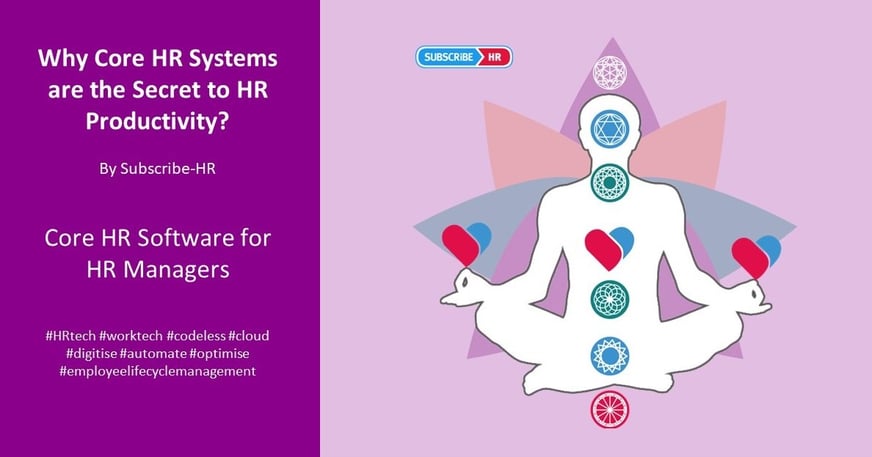Today’s HR focus is on enhancing efficiency, streamlining processes, and boosting overall productivity – it’s what is driving change at an astounding rate all around the world.
And to achieve this, HR leaders can’t get enough of these new, impressively clever core HR systems. ✨
But why are core HR systems so implemental in achieving the ultimate level of HR productivity?
In this comprehensive guide, we will be delving into the intricacies of Core HR, exploring its functionalities, and understanding why it is the secret ingredient to achieving unparalleled HR productivity. ⬇️

What is Core HR?
Core HR, or Core Human Resources, refers to the basic, essential functions that are central to managing an organisation's workforce.
It encompasses a range of activities, from employee data management to compliance and strategic planning. At its core, pun intended, it serves as the backbone of HR operations.
What does a core HR system do?
A Core HR system is a sophisticated software solution designed to automate and streamline various HR processes. It acts as a centralised hub for all HR-related data, ensuring accuracy, accessibility, and compliance.
The primary objective is to simplify administrative tasks, allowing HR professionals to focus on more strategic initiatives that contribute to organisational growth.
Why is it important to have an HR system?
According to a recent survey, 89% of C-Suite executives and 83% of HR leaders believe that HR technology enables them to be more flexible and responsive in the dynamic world of work.
The implementation of a robust HR system translates into enhanced agility and adaptability, critical factors in today's fast-paced business environment. 🙌
What is the difference between HR and core HR?
While HR broadly covers the entire spectrum of human resources management, Core HR specifically addresses the foundational elements. HR is the overarching umbrella, with Core HR nestled at its core, dealing with essential processes that form the bedrock of HR functionalities.

Core HR: The Secret to HR Productivity
Workplace leaders can all agree on the fact that HR tech is a worthy investment — a staggering 80% of HR professionals attest that investing in HR technology has not only proven beneficial but has also catalysed improvements across various facets of their business.
But how does core HR fit into different key HR processes? 👇
Streamlined HR processes
Investing in Core HR software goes beyond a mere adoption of technology; it heralds a profound transformation in the intricate web of HR processes.
At the core of the streamlining process lies the power of automation. Core HR software is engineered to automate repetitive and time-consuming tasks that traditionally demanded significant manual effort.
This automation liberates HR professionals from the shackles of routine administrative duties, allowing them to redirect their focus towards more strategic and value-added initiatives.
Automated data entry
Core HR systems excel in automating data entry and management, eliminating the need for manual input of employee information, attendance records, and other essential HR data. This not only accelerates the process but drastically reduces the probability of human errors that may arise during manual data handling.
Manual data entry is susceptible to errors, ranging from typos to miscalculations. Core HR software acts as a vigilant guardian against such errors by ensuring that data is entered accurately and consistently. This not only safeguards the integrity of HR records but also contributes to compliance and regulatory adherence.

Process consistency
Standardising HR processes is a critical aspect of efficiency. Core HR software enforces consistency in the execution of HR operations, ensuring that each task follows predefined rules and guidelines. This consistency not only enhances the overall quality of HR services but also provides a basis for continuous improvement and optimisation.
Automation and integration
Repetitive task automation
Core HR systems are redefining how HR professionals allocate their valuable time. Automation liberates HR teams from the drudgery of repetitive tasks, such as data entry, form processing, and routine communications.
This liberation is not just about efficiency gains but about empowering HR professionals to focus on high-impact, strategic activities that contribute directly to organisational growth.
Workflow automation
Beyond surface-level task automation, Core HR systems involve the orchestration of entire HR processes, from recruitment to onboarding, performance management, and beyond.
➡️ For instance, automated workflows can ensure a seamless progression of tasks during the recruitment process, from candidate screening to interview scheduling, enhancing both speed and accuracy.
Notifications and alerts
Core HR systems utilise automation to generate notifications and alerts for various HR-related events, such as performance reviews, training programs, or benefits enrollment periods.
This ensures that crucial timelines are met and that employees and HR professionals are well-informed, contributing to overall organisational agility. 👍

A seamless flow of data
Integration is the bridge that connects Core HR with other vital business systems within an organisation. This synergy ensures seamless data flow, allowing information to move effortlessly between departments.
➡️ For example, integrating Core HR with payroll systems facilitates real-time updates on employee compensation, ensuring accuracy and compliance.
Data silos, where information is isolated within specific departments or systems, hinder collaboration and decision-making. Core HR integration dismantles these silos by creating a unified data environment. This means that HR data seamlessly integrates with other critical systems like finance, operations, and customer relations, providing a holistic view of organisational performance. 👏
Enhancing operational efficiency
When Core HR systems are integrated with tools like project management software, customer relationship management (CRM) systems, and communication platforms, the result is a well-oiled organisational machinery. Tasks that require cross-functional collaboration, such as workforce planning or talent management, become more efficient and cohesive.
Integration facilitates real-time data accessibility, empowering decision-makers with up-to-the-minute insights. For instance, an integration between Core HR and business intelligence tools enables leaders to make informed decisions based on the latest workforce analytics.
Data security and compliance
In an era marked by escalating cyber threats and an ever-expanding web of stringent regulations, ensuring robust data security is absolutely critical. Thankfully though, core HR systems will allow you to do this pretty powerfully 👇
Encryption protocols and proactive security measures
Core HR systems implement state-of-the-art encryption protocols to shield sensitive employee data from potential breaches.
This involves the transformation of data into unreadable code, rendering it inaccessible to unauthorised entities by employing advanced encryption algorithms. Core HR systems not only secure data during transmission but also safeguard it within the system's databases. 🔒
Additionally, Core HR systems deploy advanced security measures to fortify defences. Threat detection and response mechanisms are incorporated to identify anomalies in user behaviour, potential breaches, or suspicious activities. Real-time alerts enable organisations to respond swiftly, minimising the impact of security incidents and maintaining the integrity of sensitive employee data.
Role-based access control and multi-factor authentication
Granular control over access to sensitive information is a cornerstone of data security. Core HR systems employ role-based access controls, ensuring that only authorised personnel can access specific data sets.
This hierarchical approach mitigates the risk of unauthorised access and inadvertent data exposure, contributing to a layered defence strategy. 👍
Furthermore, the implementation of multi-factor authentication adds an additional layer of security to Core HR systems. When you require multiple forms of identification, such as passwords, biometrics, or security tokens, you’re able to fortify access points. This proactive approach minimises the risk of unauthorised access even in the event of compromised credentials.

Ensuring regulatory compliance
Core HR systems generate comprehensive compliance reports. These reports provide organisations with a transparent view of their adherence to regulatory frameworks. Not only do these reports serve as documentation for internal governance, but they also become valuable tools during audits.
Increased efficiency
Data retrieval precision
Core HR systems revolutionise data retrieval by offering real-time accessibility to crucial information, transcending traditional methods. HR professionals can then benefit from swift access to employee records, attendance data, and performance metrics, eliminating the constraints of manual searching. This real-time data availability not only accelerates decision-making processes but also minimises delays in addressing HR-related queries.
Additionally, the customisation capabilities of Core HR systems extend to personalised dashboards, providing HR professionals with a tailored snapshot of key metrics and insights specific to their roles. These dashboards, presented in a centralised and visually intuitive format, effectively streamline data retrieval, enabling HR teams to redirect their focus towards strategic initiatives rather than sifting through extensive datasets. 📊
Agile report generation
Core HR systems boast customisable reporting tools that empower HR professionals to effortlessly generate tailored reports, whether they pertain to workforce analytics, compliance, or performance metrics.
👉 These tools facilitate the extraction of precise information, fostering unparalleled ease and enhancing the analytical capabilities of HR teams, ultimately supporting data-driven decision-making.
Moreover, these systems go beyond manual report generation by introducing automated report scheduling. HR professionals can set predefined schedules for regular report generation and distribution, eliminating the need for repeated manual efforts.
Workflow optimisation
Core HR systems optimise workflows by streamlining approval processes, eradicating bottlenecks, and reducing the time needed for decision-making. Whether handling leave requests, performance appraisals, or other HR workflows, automation ensures that approvals seamlessly progress through predefined channels, accelerating the pace of HR operations and enhancing overall organisational responsiveness.
Moreover, the efficiency gains extend to task automation and delegation within these systems. Routine and repetitive tasks, such as data entry, document routing, and communication workflows, undergo automation. This capability enables HR professionals to strategically allocate their time, concentrating on tasks demanding human expertise, creativity, and decision-making.

Continuous process improvement
The analytics capabilities of Core HR systems empower HR teams to extract actionable insights from data, fostering continuous process improvement.
Through analysing trends, identifying areas for enhancement, and measuring key performance indicators, HR professionals can utilise a data-driven approach to dynamically evolve HR operations, optimising efficiency in response to organisational needs.
In addition to this, Core HR systems facilitate feedback loops through mechanisms like performance management modules. Capturing feedback in real-time and automating performance appraisal processes, HR teams swiftly address concerns, recognise achievements, and implement improvements. These feedback loops contribute to cultivating a culture of continuous improvement, where efficiency becomes not merely a static goal but an evolving benchmark ingrained in the organisational ethos. 🙌
Better employee experiences
More accessible information for employees
Core HR systems revolutionise information accessibility by prioritising intuitive employee portals, which act as centralised hubs. These portals facilitate effortless access and updating of personal information, viewing pay stubs, and retrieving relevant HR documents.
Designed with user-friendly interfaces, these portals ensure that employees, irrespective of technical proficiency, can autonomously navigate and retrieve information, promoting a seamless and positive experience.
In tandem, the provision of real-time updates within Core HR systems enriches the employee experience dynamically. This real-time access not only aligns with the expectations of a modern workforce but also instils a profound sense of empowerment and connectivity, fostering a positive perception of the workplace.
Self-service options for employee empowerment
Core HR systems empower employees through personalised self-service options, offering a spectrum of HR transactions that enhance autonomy. This empowerment extends from submitting leave requests to independently managing personal information and benefits, streamlining HR processes and fostering a profound sense of control and ownership over one's employment journey.
This autonomy becomes a cornerstone for overall job satisfaction. Beyond administrative tasks, these systems further extend self-service options into training and development opportunities. Employees can seamlessly explore learning modules, access training materials, and enrol in professional development courses.
This integration of learning opportunities within the HR ecosystem not only aligns with contemporary career expectations but also positions the organisation as one deeply invested in the growth and well-being of its workforce, creating a holistic and satisfying employee experience. 🧑
More transparency and engagement
Core HR systems serve as robust communication channels, playing a pivotal role in cultivating transparency and engagement within the organisation.
Acting as centralised platforms, these systems disseminate a wide range of information, from organisational updates to policy changes, fostering an environment of openness and trust. This transparency not only keeps employees well-informed but also contributes to the development of a positive organisational culture.
In addition to this, Core HR systems incorporate mechanisms for collecting employee feedback, utilising tools such as surveys, suggestion boxes, and performance reviews. This proactive approach facilitates a continuous dialogue between employees and the organisation, empowering individuals to voice their opinions and concerns.
The resulting feedback loop not only enhances engagement but also provides HR teams with valuable insights, enabling them to make informed decisions that address specific concerns and contribute to the overall improvement of workplace satisfaction. 👍

Analytics and reporting
Gaining access to workforce trends
Core HR systems unlock a comprehensive understanding of workforce trends through advanced analytics. These systems go beyond conventional headcount figures, utilising data on employee demographics, retention rates, and engagement levels to provide nuanced insights into the composition and dynamics of the workforce.
This in-depth analysis facilitates strategic planning for talent acquisition, succession planning, and initiatives related to diversity and inclusion. Moreover, the analytical capabilities extend to predictive analytics, allowing organisations to anticipate future workforce trends.
Through predictive modelling, Core HR systems are able to forecast potential talent gaps, identify high-potential employees, and project future training needs. This forward-looking approach empowers organisations to proactively address challenges, strategically align resources, and stay ahead in the dynamic business environment by anticipating and preparing for future workforce dynamics. 😎
Powerful HR metrics
Core HR systems revolutionise performance management by offering comprehensive analytics that extend beyond traditional metrics, enabling a granular understanding of individual and team performance through key performance indicators (KPIs).
Integrated continuous feedback mechanisms, including real-time feedback and automated performance appraisals, foster a culture of continuous improvement, enhancing individual performance, and facilitating organisational adaptability.
Additionally, these systems can decode critical HR indicators, aligning strategic metrics with organisational goals, such as talent acquisition effectiveness, employee engagement, and workforce diversity.
Furthermore, Core HR systems provide customisable reports tailored for diverse stakeholders, ensuring relevant and actionable insights for decision-makers across the organisation, reinforcing their pivotal role in facilitating informed decision-making. 👍

How You Can Use Core HR for the 7 HR Processes: Real-Life Examples
Recruitment and onboarding
Onboarding often emerges as a pain point for companies lacking proper technology, with around one-third of HR professionals citing technology gaps as the cause of subpar onboarding experiences. Core HR systems address this challenge by streamlining the hiring process through automated applicant tracking and seamless onboarding. 👇
Onboarding Efficiency
The challenge
❌ Organisations often struggle with inefficient onboarding processes before adopting a Core HR system. The traditional onboarding approach is manual, time-consuming, and prone to delays. This can hinder employee engagement, compliance adherence, and overall operational efficiency.
The solution
To address these challenges, organisations implement a Core HR system with advanced features specifically designed to enhance onboarding efficiency ⬇️
- Streamlined Workflows: The Core HR system introduces streamlined onboarding workflows, eliminating manual processes. These workflows guide new hires through essential documentation, training modules, and policy acknowledgements in a digital environment.
- Automation for Compliance: Automated features within the system ensure that onboarding processes align with compliance requirements. This not only reduces the risk of non-compliance but also fosters a more structured and secure onboarding experience.
The results
✅ The implementation of a Core HR system for onboarding efficiency yields positive outcomes:
- Enhanced Employee Engagement: The streamlined onboarding process contributes to a more engaging experience for new hires. They can navigate through the onboarding tasks efficiently, fostering a positive impression of the organisation.
- Compliance Adherence: Automated compliance checks and features ensure that onboarding processes adhere to legal and regulatory standards. This reduces the organisation's exposure to compliance risks.
- Overall Operational Efficiency: The digital and automated onboarding processes significantly reduce administrative overhead, allowing HR teams to operate more efficiently. This efficiency extends to the broader organisation, impacting productivity positively.

Streamlined Hiring Process
The challenge
❌ Before implementing a Core HR system, many organisations grapple with a manual and time-consuming hiring process. Managing a high volume of applications becomes challenging, leading to delays in identifying suitable candidates. Additionally, the onboarding process tends to be fragmented, involving a plethora of paperwork and manual coordination.
The solution
To address these challenges, organisations opt to implement a Core HR system with advanced features for automated applicant tracking and seamless onboarding ⬇️
- Automated Applicant Tracking: The system enables organisations to create customised job postings and share them across multiple platforms. It automates the parsing of incoming applications, screens candidates based on predefined criteria, and ranks them according to their qualifications. This reduces the manual effort required for initial candidate screening, allowing the HR team to focus on more strategic aspects of the hiring process.
- Seamless Onboarding: Once a candidate is selected, the Core HR system seamlessly transitions them into the onboarding phase. Customised onboarding workflows are configured within the system to guide new hires through the necessary documentation, training modules, and policy acknowledgements. This digital onboarding experience eliminates the need for traditional paper-based processes, reducing administrative overhead and ensuring a smoother transition for new employees.
The results
✅ The Core HR system revolutionises hiring processes, bringing about positive changes:
- Efficiency: Automated applicant tracking significantly reduces initial screening time, enabling quick identification of qualified candidates.
- Candidate Experience: Streamlined and transparent application processes, coupled with automated updates, enhance the overall candidate experience.
- Onboarding: The seamless onboarding process ensures a more efficient and engaging experience for new hires. They can complete the required documentation and training at their own pace.
- Data-Driven Decisions: The Core HR system's analytics tools provide valuable insights, such as time-to-fill positions and onboarding completion rates, empowering HR leaders to make informed decisions and optimise recruitment and onboarding strategies.
Compensation and Benefits Administration
The challenge
❌ Traditional compensation and benefits administration can be complex and prone to errors, impacting accuracy, compliance, and time management.
The solution
To address these challenges, organisations implement a Core HR system with advanced features for streamlined compensation and benefits administration ⬇️
- Automated Payroll Processing: The Core HR system introduces automated payroll processing, reducing the likelihood of errors and ensuring accuracy.
The results
✅ The implementation of a Core HR system for compensation and benefits administration yields positive outcomes:
- Increased Accuracy: Automated payroll processing significantly reduces the risk of errors, ensuring accurate and precise compensation and benefits calculations.
- Enhanced Compliance: The system's automated features contribute to compliance adherence, reducing the risk of regulatory violations and associated penalties.
- Time Savings: Automated processes streamline compensation and benefits administration, saving time for HR professionals and contributing to overall operational efficiency.

HR Compliance and Risk Management
The challenge
❌ Organisations face challenges in maintaining regulatory compliance and mitigating risks without a dedicated system.
The solution
To address these challenges, organisations implement a Core HR system with advanced features for HR compliance and risk management ⬇️
- Regulatory Compliance Assurance: The Core HR system provides features that assure regulatory compliance, including continuous monitoring and updates to align with legal requirements.
The results
✅ The implementation of a Core HR system for compliance and risk management yields positive outcomes:
- Risk Mitigation: Specific features within the system contribute to risk mitigation, ensuring that the organisation operates within legal bounds.
- Legal Adherence: The system's features align with regulatory frameworks, ensuring adherence to legal requirements and minimising the risk of legal issues.
HR Analytics and Reporting
The challenge
❌ Without an efficient reporting system, organisations struggle with strategic decision-making and communication.
The solution
To address these challenges, organisations implement a Core HR system with advanced features for HR analytics and reporting ⬇️
- Strategic Decision-Making: The Core HR system provides analytics tools for strategic decision-making, offering insights into key HR metrics and trends.
- Customisable Reports for Stakeholders: The system's reporting capabilities extend to customisable reports tailored for diverse stakeholders, enhancing communication and decision support.
The results
✅ The implementation of a Core HR system for HR analytics and reporting yields positive outcomes:
- Enhanced Decision Support: Customisable reports and analytics tools provide enhanced decision support, allowing HR leaders to make informed and strategic decisions.
- Improved Communication: Stakeholders receive relevant and actionable insights through customisable reports, improving overall communication within the organisation.

Takeaway
As the landscape of HR technology continues to evolve, the takeaway is clear: organisations are recognising the pivotal role of technology in shaping the future of HR.
Zippia's report, revealing that an overwhelming 97% of employers plan to augment their investments in recruiting technology, underscores a resounding commitment to staying at the forefront of innovative hiring solutions.
This surge in investment not only reflects the growing importance of streamlined and efficient recruitment processes but also signifies a collective acknowledgement of the transformative power that technology, particularly Core HR systems and recruiting tools, holds in optimising the entire human resources journey. ✨

